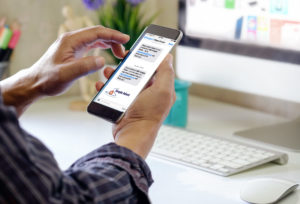
Two-way text messaging with patients
By Brandon Daniels, President and Co-founder of Dialog Health
Dialog Health is one of Simple Admit’s strategic partners. Two-way text messaging through Dialog Health is integrated into Simple Admit’s new PRM Platform.
Communicating with patients can be challenging. Traditional methods can be expensive and time consuming and are becoming less effective every day. A patient might answer the phone, might listen to their voicemail, might read a letter sent in the mail, might go to a patient portal, might follow pre/post-op instructions, or might call the facility. That is a lot of mights. The mobile phone has changed the way the world shops, socializes and, most importantly, communicates.
One of the biggest changes mobile phones have brought is how American adults engage with phone calls. Gone are the days of phone calls being a convenient, fast and efficient form of communication. A survey by TrueCaller found that 64 percent of adults have not answered a call from a number they did not recognize. If you are nodding your head in agreement, remember that many of your patients are nodding as well. This percentage of unanswered phone calls is only going to increase, call protection company First Orion predicts, as half of all mobile calls in 2019 are expected to be spam robocalls. If staff do leave a voicemail, bear in mind that, according to The New York Times, more than 30 percent of voicemails linger unheard for three days or more, and more than 20 percent of Americans do not check voicemail at all.
Phone calls are no longer the primary form of communication preferred by most American adults. Americans have not only fallen in love with texting, but they have come to rely on it in their day-to-day lives. According to The Chicago Tribune, most Americans now prefer to send/ receive a text instead of making/ receiving a phone call. Consider the impact of that statement for an ASC that still relies predominantly on phone calls as its primary patient engagement method.
When it comes to texting in America, the following research and statistics speak volumes:
According to Forbes, 95 percent of text messages are read within 3 minutes of being sent.
According to Dynmark, 98 percent of text messages are read.
According to Pew Research, in the 50–64 age range, 88 percent own a cell phone, and in the 65+ age range, 74 percent own a cell phone. Out of all cell phone users, 81 percent use their phone to text message.
According to CTIA, the average response time for a text is 90 seconds.
Texting is a cost-effective, convenient and reliable communication channel that is preferred by patients, so it should be an essential part of an ASC’s communication options.
- Two-way texting is fast, convenient and expected.
The appeal of texting for patients is that it is fast, convenient, easy, conversational and on a device that is within arm’s reach almost all the time. Texting also involves no learning curve, requires minimal effort and is already an expected part of a patient’s day. A patient simply needs to provide their mobile number to the ASC.
For an ASC, texting is a quick, reliable and cost-effective way to put relevant content at the patient’s fingertips and has a higher response rate than any other traditional forms of communication. Text messages to a patient can include dates, times, phone numbers and even links to websites, patient portals, online bill pay and surveys. Sending a text message before or after an appointment is an effective way to notify, educate, support, converse with and steer patients to other resources.
While most businesses look at text messages as an outbound reminder service, most Americans use texting for conversations. This is why the conversational nature of two-way texting is a valuable communication asset for an ASC. An incoming text message from a patient is just as valuable as an incoming phone call. An inbound text can save time and money. If a patient knows they need to cancel an appointment, do not assume they will pick up the phone and call to do so. Allowing for two-way texting is important when it comes to patient communication.
- Two-way texting can decrease phone calls and increase response rates.
Using two-way text messaging can save ASCs hours of staff time making phone calls. ASCs also can use two-way texting for other activities like direct one-to-one real-time communication, automated and scheduled appointment reminders and pre- and post-compliance messaging. It can be used for broadcast/group text messages, including emergency and weather-related information that reaches thousands of patients within minutes and would otherwise take staff days to share.
Konnie Dao of Amsurg Corporation realized that staff at her five Dallas area endoscopy centers were making more and more calls to patients the day after their procedures. “Often times patients don’t answer their phones if it is a number they don’t recognize and, while we are committed to contacting each patient after their procedure, it is a time-consuming process for our staff that can take them away from their clinical work.” Dao says. “We realized that most everyone that was coming into our facility had a mobile phone with them. So, we decided to ask the patient for their mobile number and to text them the day after their procedure to see if they needed a call from our nurse.” The results were immediate and impressive with more than an 87 percent response rate. The centers sent postop texts to 2,235 patients and got responses from 1,959 patients with 1,920 saying via text that they did not need a phone call from the nurse.
- Texting can reduce no-shows and improve compliance.
ASCs can use two-way texting throughout the patient’s journey. These messages can include automated and scheduled appointment reminders that reduce no-shows and improve compliance. The communication challenge for Lisa Fonkalsrud, center director for Tulsa Endoscopy Center in Tulsa, Oklahoma, was how to reduce no-shows and cancellations without making more phone calls. Fonkalsrud and her team created two pre-appointment text messages. The first was a two-day appointment text asking the patient to confirm the appointment and reminding them to arrive at a certain time before the appointment. The second text was sent the day before with both the arrival time and certain NPO instructions. “As a result of sending these two text messages to patients” Fonkalsrud says, “patient compliance has improved and our no-show rate in the third quarter this year was 53 percent lower than the rate for the same period last year.”
- Two-way texting can increase website and portal usage.
Texting can provide patients with a direct link to an ASC’s website/portal using a convenient hyperlink inside the text message.
For Jennifer Blanton, administrator at Physicians’ Eye Surgery Center in Charleston, South Carolina, the communication challenge was getting patients to log into the center’s online registration platform to complete their online paperwork submissions in a timely fashion, so that staff were not scrambling to get all of the information. “We created a text message to go out five days before the appointment.” Blanton says. “By putting the link to the portal in the text, we made it easy for the patient to go directly there. Our very first month of sending the texts saw an 89 percent increase in patient submissions. That is significant, especially, given the average age of our patient population.” Texting really proved its value for Blanton in the fall of 2018 when hurricanes Michael and Florence roared into the Carolinas. “Being able to communicate to patients about scheduling changes due to the hurricanes in a fast and reliable way was a blessing for our patients, our staff and our providers.” she says. “We eliminated hours and hours of calls.”
- Texting can help patients engage with their PHI.
Any ASC that is considering using texting as a communication channel must consider how to use texts with protected health information (PHI). While it is not permitted to put PHI into a standard SMS text message, texting is an effective way to direct someone to a patient portal where they can log in and view their PHI. Texting also is a great way to set up a phone call with a patient to discuss something that is PHI. Consider the following example: “Hi John. We verified your insurance for your appointment on March 15. You will have a copay. Call us today on 615.555.1234 before 4 pm so we can discuss it with you.”
At the end of the day, a good rule of thumb is: If you would leave it as a voicemail, consider sending it as a text message instead.
Selecting a Texting Platform
Not all texting solutions are the same. Consider the following when selecting a texting platform:
SaaS cloud-based solution (no need for additional hardware);
Two-way solution (for sending and receiving texts);
One platform that offers multiple solutions (ASCs can use text messages in many ways—from appointment reminders to post-op to multiple languages);
Ability to customize messages (adapts to all your ASC’s needs); and
Health Insurance Portability and Accountability Act of 1996 (HIPAA) compliant (built specifically for health care use).
Integration with pre-op software, such as Simple Admit.
This article originally appeared in ASC Focus, February 2019.


